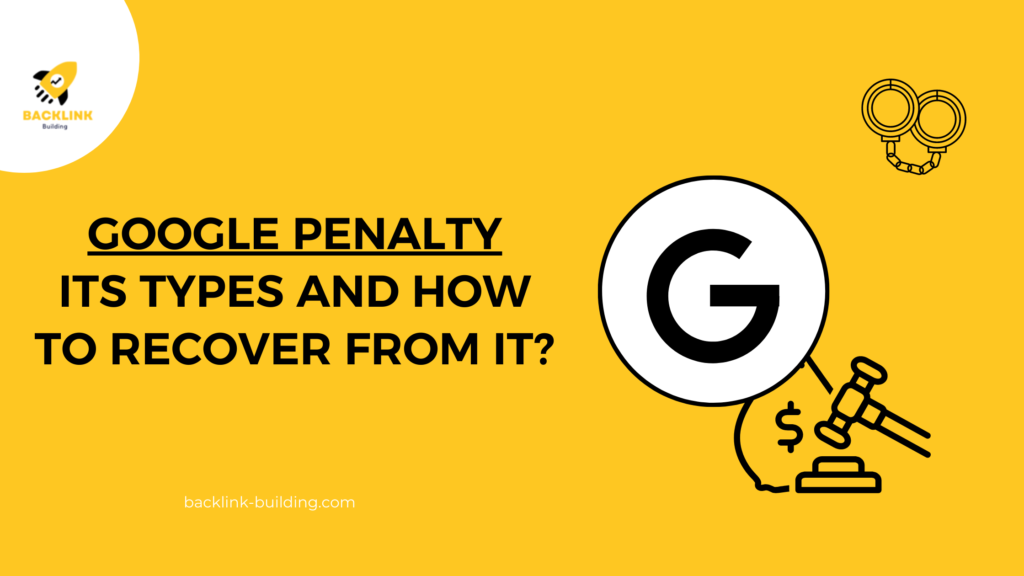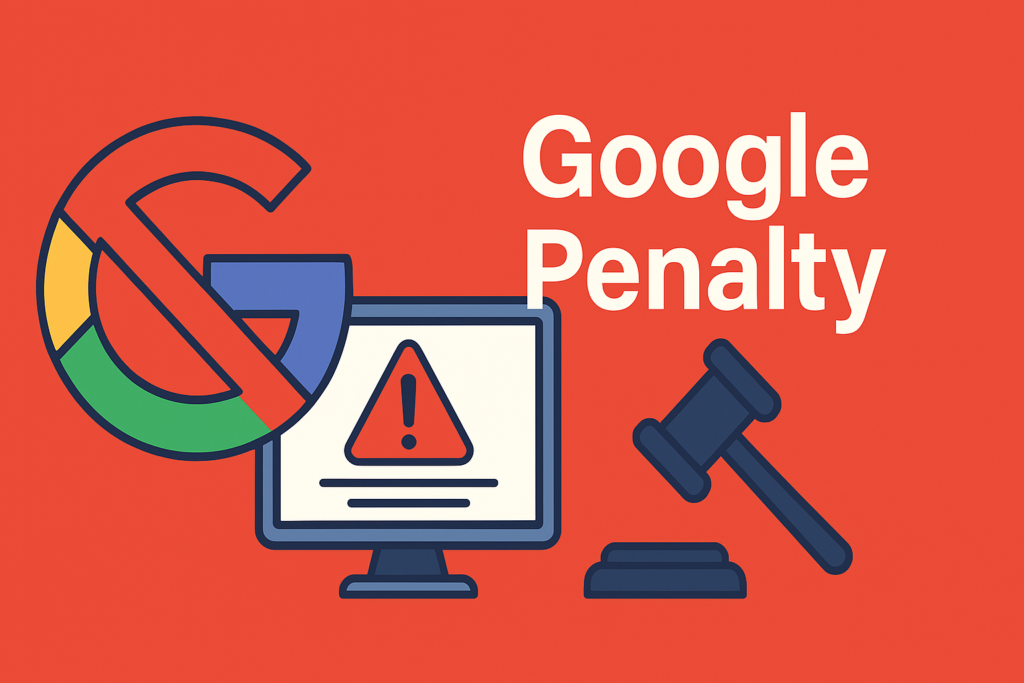
Google Penalty is a term dreaded by website owners and digital marketers alike. When a website is penalized by Google, its rankings can drop significantly and may even be removed from the search results.
This article will discuss the various types of Google Penalties, the causes of these penalties, and how to check and recover from them. We will also provide tips on preventing Google Penalties from happening in the first place.
By the end of this article, you will clearly understand what the Google Penalty is and how to avoid it.
So, let’s dive in
Definition Of Google Penalty

Google Penalty refers to the negative impact on a website’s rankings and visibility in search engine results pages (SERPs) due to non-compliance with Google’s guidelines or algorithm updates.
These penalties can be caused by various factors, including low-quality content, spammy backlinks, keyword stuffing, and other tactics that violate Google’s guidelines.
When a website is penalized by Google, its rankings can drop significantly and may even be removed from the search results.
Google’s penalties aim to provide users with high-quality, relevant search results and to prevent websites from manipulating search engines for their gain.
Types Of Google Penalties
There are two main types of Google Penalties. Such as:
- Algorithmic: Algorithmic penalties are applied automatically by Google’s search algorithms.
- Manual: These penalties are being applied, while human reviewers apply manual penalties.
This section will discuss the different types of Google Penalties, with examples of each.
Algorithmic Penalties
Panda Penalty
The Panda Penalty targets websites with poor-quality or duplicate content. It was introduced in 2011 and has since been updated multiple times.
The main goal of this penalty is to ensure that websites with a high-quality content rank higher in search results.
Panda penalty targets sites with thin content, duplicate content, keyword stuffing, and low-quality content.
Example: A website that frequently publishes low-quality or duplicate content may face a Panda Penalty.
Penguin Penalty
The Penguin Penalty targets websites that use spammy link-building tactics to manipulate search engine rankings. It was first introduced in 2012 and has since been updated multiple times.
This penalty ensures that websites with natural and high-quality backlinks rank higher in search results.
Example: A website that uses black hat SEO tactics to gain backlinks, such as link buying, link farming, and excessive link exchanges, may face a Penguin Penalty.
Hummingbird Penalty
The Hummingbird Penalty targets websites that use irrelevant or spammy keywords to manipulate search engine rankings. It was introduced in 2013 and aimed to provide more accurate search results by understanding the intent behind the search query.
Example: A website that uses irrelevant or spammy keywords to manipulate search engine rankings may face a Hummingbird Penalty.
Manual Penalties
Unnatural Links Penalty
The Unnatural Links Penalty targets websites that use unnatural or spammy backlinks to manipulate search engine rankings. It is applied manually by Google reviewers.
Example: A website with spammy or unnatural backlinks to manipulate search engine rankings may face an Unnatural Links Penalty.
Thin Content Penalty
The Thin Content Penalty targets low-quality or thin websites that provide users little or no value. It is applied manually by Google reviewers.
Example: A website with low-quality or thin content that provides little or no value to users may face a Thin Content Penalty.
Cloaking Penalty
The Cloaking Penalty targets websites that use cloaking techniques to deceive search engines. Cloaking refers to showing different content to search engine crawlers rather than human users.
Example: A website that uses cloaking techniques to deceive search engines may face a Cloaking Penalty.
How To Check For Google Penalty
If you suspect that your website has been penalized by Google, confirming this before taking any corrective action is essential.
Here are some ways to check for a Google Penalty:
Manual Penalty Notifications
Google sends manual penalty notifications to website owners via Google Search Console. These notifications explain the reason for the penalty and the steps required to recover from it.
If you receive a manual penalty notification, you should take immediate action to correct the issues mentioned in the notification.
Google Search Console
You can also check for algorithmic penalties in Google Search Console. Login to your account and navigate the “Security & Manual Actions” section.
Here you will find information on any manual penalties applied to your website and security issues that may have resulted in a penalty.
You can also check for algorithmic penalties in the “Performance” section by analyzing your website’s traffic and ranking trends.
Google Penalty Checker Tools
Several Google Penalty Checker tools are available online to help you identify if your website has been penalized by Google. These tools analyze your website’s traffic and ranking data to identify any sudden drops in traffic or ranking that may indicate a penalty.
Ahrefs
Ahrefs is a popular SEO tool that provides detailed insights into your website’s search engine performance.
It has a “Site Audit” feature can help you identify any technical SEO issues affecting your website’s ranking.
The tool also has a “Site Explorer” feature that allows you to analyze your backlink profile and identify any spammy backlinks affecting your website’s ranking.
SEMrush
SEMrush is another popular SEO tool that can help you identify any Google Penalties affecting your website.
The tool has a “Site Audit” feature that checks your website for technical SEO issues and recommends fixing them. It also has a “Backlink Audit” feature that analyzes your backlink profile and identifies any spammy backlinks.
How To Recover From Google Penalty
If your website has been penalized by Google, here are some steps you can take to recover from the penalty:
Identify The Cause Of The Penalty
The first step to recovering from a Google Penalty is to identify the cause of the penalty.
You can use the methods mentioned in the previous section to check if your website has been penalized and determine the type of penalty. This will help you understand the cause of the penalty and take corrective action accordingly.
Fix The Issue
Once you have identified the cause of the penalty, you need to take corrective action to fix the issue.
This may involve removing low-quality content, fixing technical SEO issues, removing spammy backlinks, or any other action required to address the cause of the penalty. Make sure to follow Google’s guidelines when making changes to your website.
Submit A Reconsideration Request
If your website has been manually penalized by Google, you can submit a reconsideration request through Google Search Console.
In your request, you should explain the actions you have taken to address the cause of the penalty and provide evidence to support your claims. Be patient; it may take time for Google to review your request.
Disavow Bad Links
If your website has been penalized due to spammy backlinks, you can use Google’s disavow tool to disavow these links.
This will tell Google you want to keep these links from being counted toward your website’s ranking. However, use the disavow tool cautiously, as it can harm your website’s ranking if misused.
Build High-Quality Backlinks
Building high-quality backlinks is an essential part of any SEO strategy. Focus on building natural backlinks from authoritative websites in your industry. Avoid using link-building tactics that violate Google’s guidelines.
Improve User Experience
User experience is becoming an increasingly important ranking factor for Google. Make sure your website is fast, mobile-friendly, and easy to navigate. Provide high-quality content that is relevant to your audience and engages them.
Final Thoughts
Now that you have understood the Google penalty in detail. Now it’s time for you to check if there’s any penalty on your website and get it resolved quickly.
If you need help understanding the blog, please comment in the comment section. We will be happy to help you.
Thanks for reading 🙂


